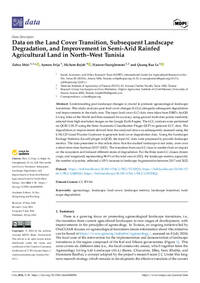Data on the Land Cover Transition, Subsequent Landscape Degradation, and Improvement in Semi-Arid Rainfed Agricultural Land in North–West Tunisia

Authors:
Understanding past landscape changes is crucial to promote agroecological landscape transitions. This study analyzes past land cover changes (LCCs) alongside subsequent degradation and improvements in the study area. The input land cover (LC) data were taken from ESRI’s ArcGIS Living Atlas of the World and then assessed for accuracy using ground truth data points randomly selected from high-resolution images on the Google Earth Engine. The LCC analyses were performed on QGIS 3.28.15 using the Semi-Automatic Classification Plugin (SCP) to generate LCC data. The degradation or improvement derived from the analyzed data was subsequently assessed using the UNCCD Good Practice Guidance to generate land cover degradation data. Using the Landscape Ecology Statistics (LecoS) plugin in QGIS, the input LC data were processed to provide landscape metrics. The data presented in this article show that the studied landscape is not static, even over a short-term time horizon (2017–2022). The transition from one LC class to another had an impact on the ecosystem and induced different states of degradation. For the three main LC classes (forest, crops, and rangeland) representing 98.9% of the total area in 2022, the landscape metrics, especially the number of patches, reflected a 105% increase in landscape fragmentation between 2017 and 2022.
